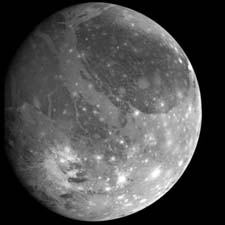Return to Index |
Previous Image |
Next Image |
Ganymede is the
fourth of Jupiter's four Jovian moons. Approximately 5,200 kilometers
across and with a mass of 1.5 x 1026 kg, Ganymede is the largest
satellite in our solar system. It has an orbital period of a little over
seven Earth days. Ganymede is deeply immersed the Jovian plasma environment
surrounding Jupiter, and readily interacts with it. Its low density of
1.94 gm/cm3 suggests that it is not particularly solid, and
that water or ice most likely fills much of its interior structure, mimicking
the icy covering visible in satellite pictures. Its core takes up 50%
of its diameter, and is most likely comprised of rock. Satellite images
reveal detailed tectonic features on the surface. These features include
fragmented regions of dark terrain split by layers of bright grooved terrain
covering surface. The dark regions are especially cratered, suggesting
that they are the oldest part of Ganymede's surface. Several bright young
craters can be seen on the surface, including a linear chain of craters
near the center of the image, which may have resulted from the impact
of fragmented comets. While Ganymede has no known atmosphere, Hubble has
recently detected ozone at its surface. This ozone is produced as charged
particles trapped in Jupiter's magnetic field rain down on the surface,
interacting with the icy surface. This reaction produces ozone, suggesting
that Ganymede may have a thin oxygen atmosphere. (Courtesy of Voyager
2 mission by NASA)
References:
http://www.jpl.nasa.gov/galileo/sepo
http://www-pdsimage.jpl.nasa.gov/cgi-bin/GCBGenCatalogPage.pl?08201996
Object |
Distance from Earth |
Wavelength |
Ganymede |
42
light minutes |
Optical |

